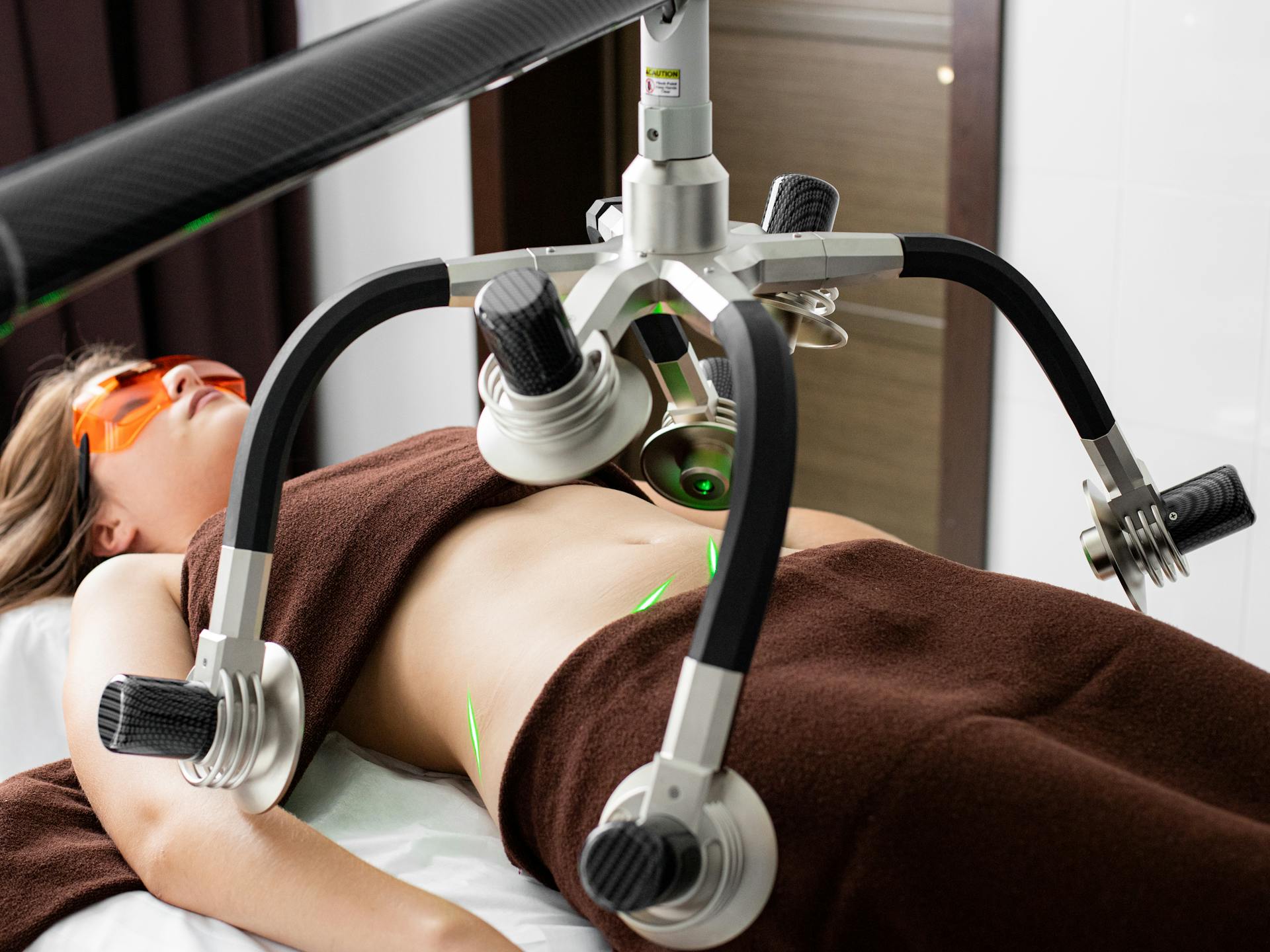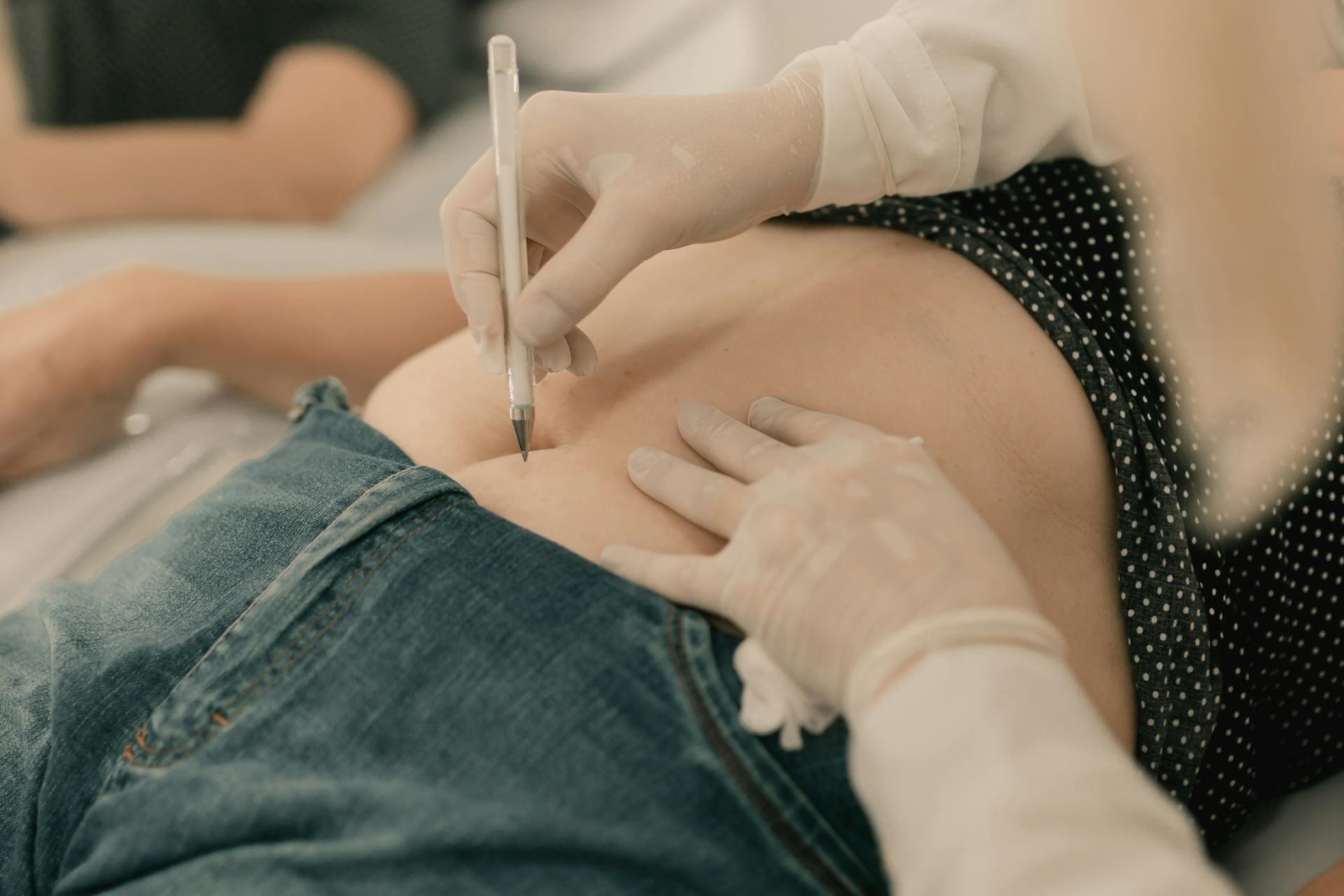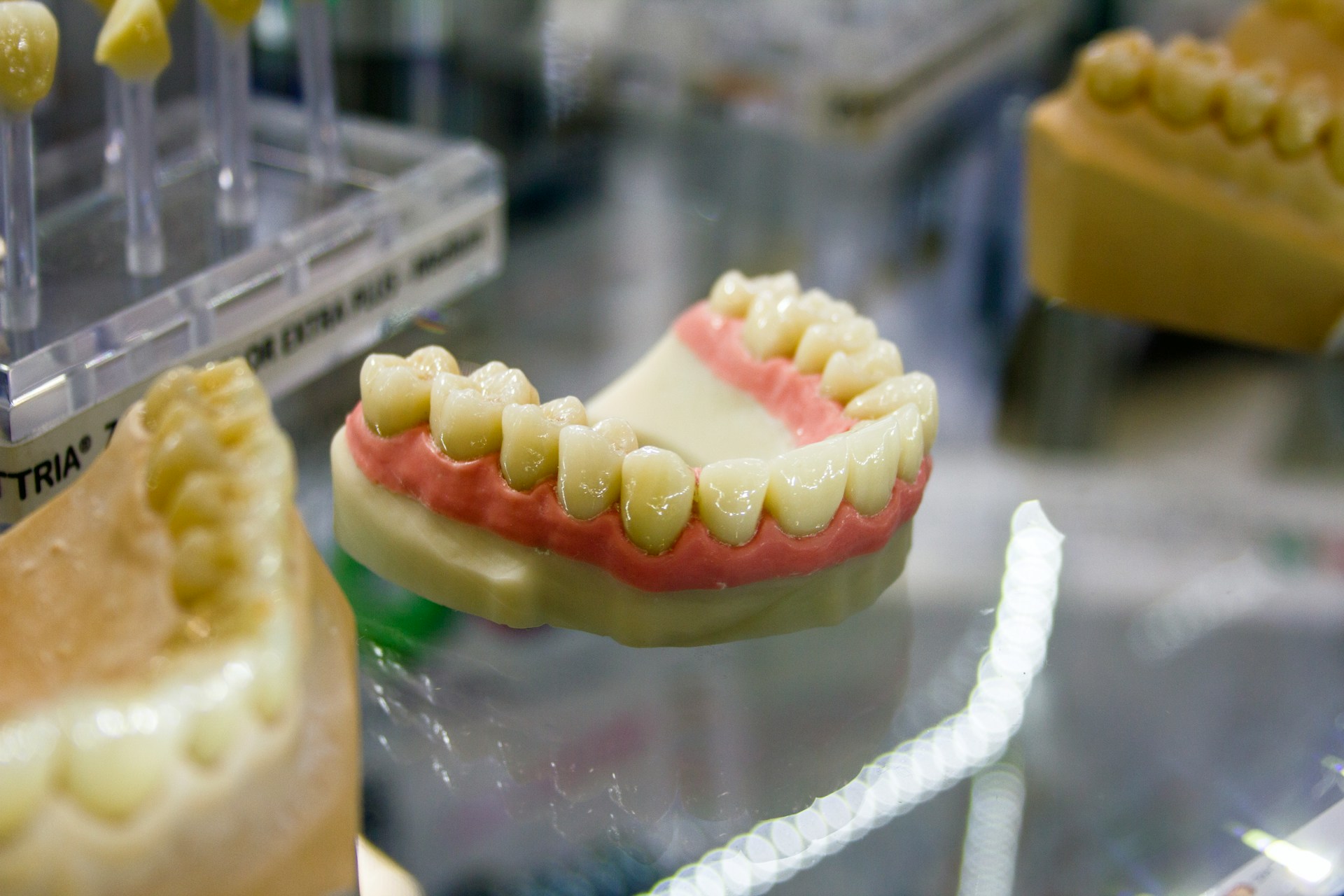Liposuction is a widely recognised cosmetic procedure aimed at eliminating stubborn fat and enhancing body contours. However, it is important to carefully evaluate liposuction risks and benefits before proceeding with the treatment.
If you find yourself wondering about how liposuction works, the potential complications, or whether you might be an ideal candidate, it is crucial to understand the entire process. This article provides a comprehensive overview, covering everything from the mechanics of liposuction to recovery options and alternative fat reduction techniques. With this information, you will be well-equipped to make an informed decision.
What Is Liposuction?

Liposuction is a widely recognised cosmetic surgery procedure aimed at removing fat from specific areas of the body, ultimately enhancing body contouring and improving overall appearance. This surgical technique employs advanced technology to effectively eliminate stubborn fat, giving patients an opportunity to reshape their bodies.
While the cost of liposuction can vary based on the treatment area, the surgeon’s expertise, and the chosen technique, it remains a popular investment for individuals seeking long-term solutions to achieve their aesthetic goals.
It is important to be aware of the various facets of liposuction, including its benefits, risks, and the critical need to select a board-certified surgeon to ensure optimal patient safety and satisfaction. Engaging in a consultation with a qualified professional can provide valuable insights into candidacy, anticipated results, and the comprehensive approach required before, during, and after the procedure.
How Does Liposuction Work?
Liposuction is a surgical procedure that utilises various techniques, such as the tumescent technique and ultrasound-assisted liposuction, to effectively eliminate unwanted fat deposits from specific areas of the body. During the procedure, anaesthesia is administered to ensure the patient’s comfort, and small incisions are made to facilitate the insertion of a cannula, a thin tube used to suction out the fat. It is important for prospective patients to understand how liposuction works to set realistic expectations, including whether the results are permanent, and to prepare adequately for the recovery process.
The tumescent technique involves injecting a large volume of saline solution mixed with anaesthetic. This approach minimises bleeding and enhances fat removal by making the tissue firmer, allowing for a more precise and controlled extraction of fat. On the other hand, ultrasound-assisted liposuction uses ultrasonic waves to liquefy fat, making it easier to suction out. This technique can be particularly effective for denser fat deposits.
While the fat removed during liposuction does not regenerate, the procedure is only permanent if patients maintain a stable weight through healthy lifestyle choices. Significant weight gain after the procedure can lead to the accumulation of fat in untreated areas, which may impact the overall results.
The overall process generally begins with a consultation, followed by pre-operative preparations, and culminates in post-operative care to ensure optimal healing and long-lasting results.
What Are the Risks of Liposuction?

Liposuction is typically considered a safe procedure; however, it does come with certain risks that individuals should take into account before deciding to proceed.
Common risks include complications such as infection, bleeding, and issues related to anaesthesia, all of which can affect patient safety and the overall recovery process.
Furthermore, it is essential to recognise the potential emotional impact and changes in body image that may occur after surgery. This understanding is key to managing expectations and adequately preparing for post-operative care and follow-up appointments.
Being well-informed about these risks can significantly improve decision-making and enhance satisfaction rates for patients.
1. Infection
Infection is a notable risk associated with liposuction, and if not addressed promptly, it can lead to serious complications. This risk can arise at the incision sites or within the deeper tissues, highlighting the importance of patient safety and proper post-operative care to minimise these concerns.
Patients should be attentive to any signs of infection, which may manifest as increased redness, swelling, discharge of pus, or the development of a fever several days after the procedure. Early recognition of these symptoms is essential, as immediate medical intervention can help prevent further health complications.
Following the surgeon’s post-operative care instructions—such as practising proper wound care, avoiding strenuous activities, and keeping up with follow-up appointments—is crucial in significantly reducing the risk of infections.
Therefore, anyone considering liposuction should prioritise understanding these factors to ensure a smooth recovery and achieve optimal results.
2. Bleeding
Bleeding is a potential risk associated with liposuction, primarily due to the invasiveness of the surgical procedure. This can lead to complications such as haematomas or excessive blood loss. It is essential to employ proper surgical techniques and maintain diligent monitoring to minimise these risks and facilitate a safe recovery.
Understanding the underlying factors that contribute to bleeding during this cosmetic procedure is critical. Elements such as the use of anticoagulants, pre-existing medical conditions, and the extent of fat removal can increase the likelihood of complications.
Surgeons must carefully balance achieving aesthetic goals with ensuring patient safety. Excessive bleeding can not only prolong the recovery process but also result in serious complications, such as shock or infection.
To mitigate these risks, experienced surgeons utilise advanced techniques and technologies, including tumescent anaesthesia, which aids in constricting blood vessels. Thorough pre-operative assessments and continuous clinical monitoring are vital in safeguarding the patient’s well-being throughout the procedure.
3. Numbness
Numbness can be a temporary side effect following liposuction, often resulting from nerve irritation during the surgical procedure. This may influence the recovery time for some patients, so understanding this side effect can help establish realistic expectations for post-operative sensations.
Typically, this numbness is experienced in the treated areas and can last anywhere from a few weeks to several months, depending on an individual’s healing process. It is important for patients to recognise that, while unsettling, this sensation is generally a normal aspect of the recovery journey.
To alleviate any discomfort, patients can adopt a few strategies, such as:
- Gently massaging the area
- Staying well-hydrated
- Following their surgeon’s aftercare instructions diligently
Additionally, utilising prescribed medications for pain management can help ease any associated symptoms, including the persistent numbness, as the body heals and sensation gradually returns.
4. Scarring
Scarring is an inevitable outcome of any surgical procedure, including liposuction. However, employing techniques such as minimally invasive approaches can help minimise the visibility of scars over time. Factors such as skin elasticity and the surgeon’s expertise can significantly impact the degree of scarring experienced after the surgery.
Moreover, individual healing responses and pre-existing skin conditions are crucial in determining how scars develop. For instance, some individuals may find that their scars are more pronounced due to genetic predisposition, while others may heal with little to no visible trace of the procedure.
To effectively manage or minimise scarring during the recovery phase, it is essential to adhere closely to post-operative care instructions. This includes keeping the incision site clean and moisturised. Additionally, using silicone gel sheets or scar creams, as recommended, can further improve the appearance of scars.
Implementing sun protection measures is also important, as it can prevent scars from darkening, leading to a more uniform skin tone as healing progresses.
5. Skin Irregularities
Skin irregularities can occasionally occur as a side effect of liposuction, which may impact the overall results and appearance. This is particularly true if the skin lacks elasticity or if proper techniques are not employed during the procedure. To address these concerns, individuals might consider skin tightening treatments after undergoing liposuction.
These irregularities can manifest as lumps, bumps, or uneven textures, and they may be further influenced by factors such as age, genetic predisposition, and an individual’s natural skin tone. The healing process also plays a significant role, as it can affect how the skin responds to the changes made during the surgery.
For those who are dealing with these issues, exploring non-invasive solutions such as:
- ultrasound therapy
- radiofrequency treatments
- more traditional options like laser therapy
can significantly improve skin smoothness and firmness. Consulting with a qualified practitioner can provide valuable insights into the most suitable approach tailored to each individual’s skin type and concerns.
6. Fluid Accumulation
Fluid accumulation, commonly referred to as seroma, is a frequent occurrence following liposuction. This condition involves the collection of fluid in pockets beneath the skin, making diligent post-operative care and monitoring essential during the recovery phase to facilitate proper healing.
This phenomenon typically arises as the body responds to the trauma of surgery, resulting in an imbalance in fluid regulation. During recovery, the body may direct excess fluids to the surgical site, leading to these problematic pockets.
To manage fluid accumulation effectively, it is vital for individuals to follow their surgeon’s post-operative instructions closely. This may include wearing compression garments, which can help minimise swelling and provide support to the skin as it heals.
In addition, staying well-hydrated and maintaining a balanced diet can further promote healing. Regular follow-up appointments are also important, as they allow medical professionals to monitor recovery progress and promptly address any complications that may arise.
7. Anesthesia Complications
Anaesthesia complications, while uncommon, can present significant risks during liposuction procedures, including adverse reactions or respiratory issues. This underscores the importance of conducting thorough pre-operative tests and carefully assessing the patient’s medical history.
Before proceeding with such surgeries, it is essential for patients to have a detailed conversation with their healthcare provider. They should be made aware of the different types of anaesthesia available, the specific health risks tied to their individual conditions, and the potential implications of each option.
Taking this proactive approach not only alleviates anxiety but also ensures that patients understand how anaesthesia may impact them during and after the procedure. Comprehensive medical consultations give the power to individuals to make informed decisions, thus enhancing their overall safety and minimising the likelihood of complications.
What Are the Benefits of Liposuction?

Liposuction presents a range of benefits, which is why it has become a preferred option for those looking to improve their body contour and remove excess fat.
This cosmetic procedure effectively targets stubborn fat deposits, and it can also enhance self-confidence by improving body image and producing realistic results tailored to each individual’s goals.
By recognising these advantages, individuals can feel more give the power toed to make informed decisions about their physical and emotional well-being.
1. Removes Stubborn Fat
One of the key advantages of liposuction is its effectiveness in eliminating stubborn fat that often resists both diet and exercise. This results in improved body contouring and a heightened satisfaction with one’s overall physical appearance.
This cosmetic procedure specifically focuses on areas where fat tends to accumulate, such as the abdomen, thighs, hips, and arms. It typically produces more significant changes than what can be achieved through lifestyle adjustments alone.
Many individuals experience localised fat deposits that persist despite their best efforts, which can be quite frustrating and may lead to a loss of confidence. By removing these stubborn pockets of fat, patients can anticipate a more sculpted silhouette that highlights their natural curves, contributing to a greater sense of body harmony.
This transformative effect often enhances self-esteem and fosters a renewed sense of personal style.
2. Improves Body Contour
Liposuction plays a significant role in enhancing body contour by reshaping specific areas of concern, enabling individuals to achieve their aesthetic goals through cosmetic surgery.
This procedure is particularly effective in targeting stubborn fat deposits found in regions such as the abdomen, thighs, and hips, which often do not respond well to diet and exercise. By removing excess fat, liposuction helps to sculpt and define these areas, resulting in a more balanced and harmonious silhouette.
It is essential for prospective patients to approach this option with realistic goals and expectations, recognising that liposuction is not intended as a weight loss solution but rather as a means to enhance one’s natural shape.
Engaging in a thorough discussion about desired outcomes with a qualified surgeon can facilitate the development of a personalised plan tailored to individual body types.
3. Boosts Self-Confidence
Many patients report a notable increase in self-confidence after undergoing liposuction. This procedure can lead to a more positive body image and significantly impact one’s emotional well-being in everyday life.
The transformation often occurs gradually as individuals begin to notice changes in their physique, leading to greater comfort in their own skin. For example, one recent patient shared her experience of eliminating stubborn fat and how this give the power toed her to explore new fashion choices that she previously considered off-limits.
Post-surgery support groups frequently encourage participants to share their experiences, illustrating how improved self-esteem can positively influence various aspects of life, including personal relationships and professional opportunities.
These testimonials underscore that liposuction is not merely a cosmetic procedure; for many individuals, it represents the start of a renewed self-awareness and appreciation for their bodies.
4. Can Be Combined with Other Procedures
Liposuction is often effectively combined with other cosmetic procedures, such as fat grafting, to enhance the overall results and help individuals achieve their comprehensive body transformation goals.
This combination allows for a more sculpted appearance, as the fat removed during liposuction can be reinjected into areas that need added volume, such as the breasts or buttocks.
When liposuction is paired with an abdominoplasty, it can tackle both stubborn fat and excess skin, leading to a firmer and more contoured abdomen. Similarly, combining liposuction with body lift surgery can yield significant improvements in body shape, particularly after substantial weight loss.
These clinical combinations not only optimise the outcomes for patients but also play a crucial role in improving self-esteem and body confidence by creating a more balanced physique.
Who Is a Good Candidate for Liposuction?
Determining a suitable candidate for liposuction requires careful consideration of several important factors, such as overall health, stable weight, and realistic expectations about the outcomes.
Typically, candidates should be in good health and have a body mass index (BMI) that falls within an acceptable range to ensure safety during the surgical procedure.
1. Generally Good Health
Candidates considering liposuction should generally be in good health, as this is crucial for minimising surgical risks and facilitating a smooth recovery process. A comprehensive medical history and pre-operative tests are essential steps in assessing eligibility.
Maintaining an optimal state of health not only allows for better outcomes but also reduces the likelihood of complications during and after the procedure. Certain medical conditions, such as diabetes, heart disease, or uncontrolled hypertension, can significantly hinder a patient’s ability to heal and may increase the risk of adverse events.
Individuals with bleeding disorders or a history of poor wound healing may also encounter heightened risks. Therefore, it is essential for potential patients to consult with their healthcare provider to thoroughly evaluate their health background, ensuring they meet the necessary criteria for a safe and effective liposuction experience.
2. Stable Weight
Maintaining a stable weight is essential for individuals considering liposuction, as this procedure is designed not for weight loss but for body sculpting by removing specific fat deposits.
Keeping a consistent weight helps ensure that the results of the procedure are both aesthetically pleasing and long-lasting. It is important for candidates to recognise that while liposuction can improve one’s body image by eliminating stubborn fat pockets, it should not be viewed as a substitute for a healthy lifestyle or a primary method for achieving significant weight loss. This distinction is crucial, as individuals with fluctuating weights may encounter uneven results, which can lead to dissatisfaction.
Therefore, those thinking about this cosmetic surgery should aim to reach their ideal weight, as a stable foundation allows for optimal shaping and contouring of their figure, ultimately enhancing their confidence.
3. Realistic Expectations
Setting realistic expectations is essential for those considering liposuction, as it can significantly improve body contour but is not a means to achieve perfection.
Understanding the potential outcomes of liposuction is crucial to avoid disappointment since individuals may respond differently to the treatment based on various factors, including body type, skin elasticity, and lifestyle habits. Patient education plays a vital role in this process, enabling individuals to recognise what is achievable and what lies beyond the procedure’s capabilities.
Having in-depth discussions with healthcare providers can help clarify any uncertainties and establish achievable goals, allowing candidates to visualise their transformation while remaining grounded in reality. This proactive approach promotes a healthy mindset and significantly enhances the overall experience and satisfaction with their decision.
4. Specific Target Areas
Candidates should consider specific target areas for liposuction, as this procedure is designed to address localised fat deposits in regions such as the abdomen, thighs, arms, and back.
Each individual possesses unique body contours and aesthetic goals, allowing professionals to tailor the procedure to effectively target stubborn areas like the flanks, chin, or calves, thereby ensuring optimal results.
For example, one person may wish to achieve a more sculpted waistline by concentrating on the abdomen and love handles, while another might focus on enhancing the shape of their thighs by removing excess fat.
By understanding these personalised requests, professionals can enhance overall body symmetry and boost confidence, making liposuction a versatile option for individuals looking to refine their physique.
How Is Liposuction Performed?

The process of liposuction is a well-planned surgical procedure that employs advanced technology and techniques to achieve optimal results while prioritising patient safety and comfort during anaesthesia administration.
After an initial consultation, the journey begins with the careful marking of targeted areas for fat removal, which helps in visualising the desired outcomes. The surgeon then chooses the most suitable liposuction technique, which may include tumescent, ultrasound-assisted, or laser-assisted methods. Each of these techniques offers distinct advantages tailored to the specific needs of the patient.
Anaesthesia plays a crucial role in this procedure, as it minimises discomfort and helps the patient remain relaxed throughout the operation. Once the procedure is complete, diligent post-operative care becomes essential. This includes wearing compression garments, managing pain with prescribed medications, and following up with the healthcare provider to ensure a smooth recovery and achieve the best possible results.
What Is the Recovery Process Like?
The recovery process following liposuction can differ significantly from one individual to another. However, it typically involves managing issues such as scarring, bruising, and swelling as the body undergoes healing.
Ensuring proper post-operative care and attending follow-up appointments are essential for a smooth recovery and achieving optimal results.
In the initial days after the procedure, patients can expect to experience a variety of symptoms, including mild discomfort, which is generally manageable with prescribed medications. Significant bruising or swelling usually reaches its peak within the first week and gradually diminishes over the subsequent weeks.
It is crucial for individuals to follow their surgeon’s aftercare instructions closely, such as wearing compression garments, as these measures support the healing process. Follow-up appointments are particularly important, as they provide medical professionals with the opportunity to monitor progress, address any concerns, and make necessary adjustments to the recovery plan.
Being proactive during this phase can greatly enhance overall satisfaction with the final results.
Are There Any Alternative Options to Liposuction?

For individuals contemplating body contouring but feeling uncertain about liposuction, there are several alternative options to explore.
These include lifestyle changes such as diet and exercise, in addition to non-surgical and minimally invasive techniques that can help achieve similar results.
1. Diet and Exercise
Diet and exercise are fundamental components of any weight loss journey, promoting a healthy body image and overall wellness. They can serve as effective alternatives or complements to liposuction.
By emphasising a balanced nutrition plan and incorporating regular physical activity, individuals can achieve sustainable weight loss while simultaneously boosting their self-esteem. Unlike surgical procedures, these lifestyle changes not only lead to a more toned physique but also foster a sense of accomplishment and give the power toment.
Engaging in consistent workouts and making mindful food choices play a significant role in enhancing mental well-being.
As individuals notice the positive transformations in their bodies and health, they often experience a boost in confidence and satisfaction with their appearance. Therefore, diet and exercise are invaluable tools for anyone looking to transform their lives.
2. Non-Invasive Fat Reduction Techniques
Non-invasive fat reduction techniques such as laser lipolysis and ultrasound-assisted fat removal have become increasingly popular as alternatives to liposuction. These methods provide effective solutions without the need for surgical intervention.
Utilising advanced technology, these techniques specifically target and eliminate stubborn fat cells, allowing clients to achieve noticeable results in a more comfortable and less invasive environment.
For example, laser lipolysis uses focused laser energy to break down fat deposits, leading to a smoother physique and quicker recovery times. Similarly, ultrasound-assisted fat removal employs sound waves to displace fat while leaving surrounding tissues unharmed, making it a safe option for many individuals.
When compared to traditional liposuction, these strategies typically involve fewer risks, reduced downtime, and minimal side effects. This makes them particularly appealing to those looking for effective body contouring without the complexities associated with surgery.
3. Tummy Tuck
A tummy tuck, also known as abdominoplasty, is a surgical option worth considering for individuals interested in fat removal and body contouring. Often, this procedure is performed alongside liposuction to achieve the best possible results.
The primary focus of a tummy tuck is to remove excess skin and fat from the abdominal region while tightening the underlying muscles. Unlike liposuction, which specifically targets fat deposits, a tummy tuck proves particularly advantageous for those who have undergone significant weight loss, experienced pregnancy, or dealt with the effects of ageing, all of which can lead to a loss of skin elasticity.
The specific benefits of a tummy tuck include a flatter, firmer abdominal profile and improved muscle tone, which can greatly enhance an individual’s overall body shape. This combination of fat and skin removal results in a smoother and more contoured silhouette, making it an appealing choice for many individuals seeking to achieve a more sculpted figure.
Frequently Asked Questions on Liposuction Risks and Benefits
What is liposuction and how does it work?
Liposuction is a cosmetic surgical procedure that removes excess fat from various areas of the body. It involves using a thin tube called a cannula to suction out fat cells, resulting in a slimmer and more contoured appearance.
What are the risks associated with liposuction?
As with any surgical procedure, liposuction carries certain risks such as infection, scarring, and adverse reactions to anaesthesia. Additionally, there is a risk of damage to surrounding tissues, nerve damage, and uneven or bumpy results.
Who is a good candidate for liposuction?
Individuals who are in good overall health, have a stable weight, and have specific areas of stubborn fat are typically good candidates for liposuction. It is important for candidates to have realistic expectations and maintain a healthy lifestyle after the procedure.
What are the benefits of liposuction?
Liposuction can provide a more defined and balanced body contour, reduce the appearance of cellulite, and improve self-confidence. It can also be used for medical reasons, such as treating lipomas (benign fatty tumours) and gynecomastia (enlarged male breasts).
What is the recovery process like after liposuction?
The recovery time for liposuction varies depending on the extent of the procedure and the individual’s healing ability. Generally, patients can expect some swelling, bruising, and discomfort for the first few days. Most people are able to resume normal activities within 1-2 weeks and see final results within 6-12 months.
Are there any alternative treatments to liposuction?
Yes, there are non-surgical alternatives to liposuction such as cryolipolysis (fat freezing), laser lipolysis, and ultrasound-assisted liposuction. These procedures typically have less downtime and a lower risk of complications, but may require multiple sessions to achieve desired results.












